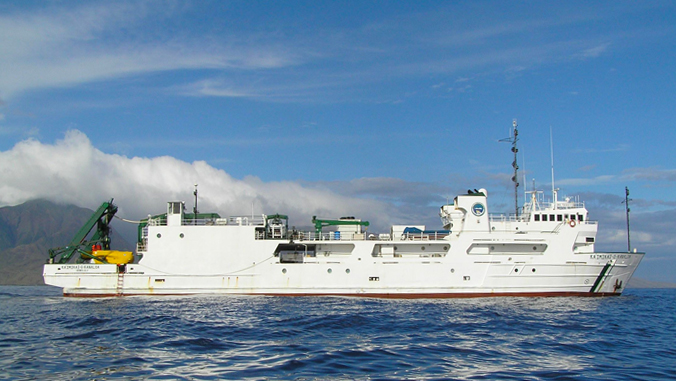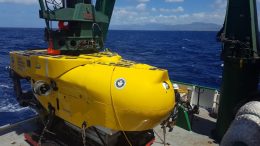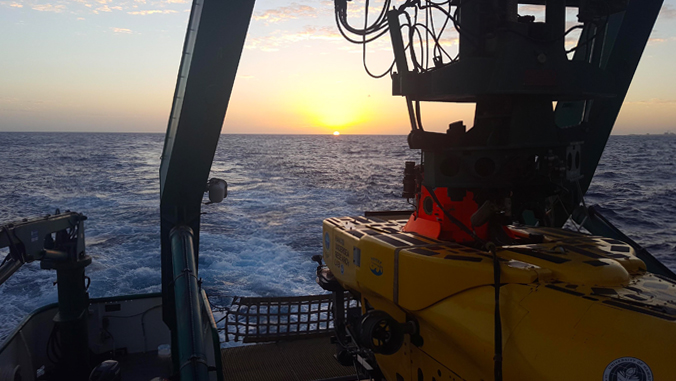
A reception was held on the University of Hawaiʻi research vessel Kaʻimikai-O-Kanalo (“Heavenly Searcher of the Seas of Kanaloa”) just before she was sold this fall. Affectionately known to many as the K-O-K, the ship joined the fleet of UH marine expeditionary research vessels on January 15, 1994. Since then, K-O-K has been used across the Pacific Ocean on a variety of missions that included submersible operations, deployment of deep-sea moorings, hydrographic surveys and studies of marine biology, chemistry and climate change.
The original vessel was built by Mangrove Shipbuilding Co., Houston, Texas, in 1979 and was used for more than a decade for oil and gas exploration. Starting in 1992, UH oceanographer and director of the Hawaiʻi Undersea Research Laboratory (HURL), Alex Malahoff, worked tirelessly to acquire and reconfigure this 185-foot offshore supply vessel to serve as a support ship for HURL’s two human-occupied submersibles, Makaliʻi and Pisces V, the remotely-operated vehicle RC V-150. After the vessel Makaliʻi was retired, K-O-K also supported the submersible Pisces IV.
Attendees at the reception included Beverly Malahoff, who christened the reconfigured R/V Kaʻimikai-O-Kanaloa when she emerged from Bender Shipbuilding and Repair Co. as a versatile 223–foot oceanographic research vessel with a cruising speed of 10 knots, a 15,000 nautical mile range, 50–day endurance, and space for 14 crew members and 19 scientists. The approximately $5 million conversion was funded by the state of Hawaiʻi and NOAA, with the state holding the ship’s title.
K-O-K’s greatest accomplishments

K-O-K facilitated research in Hawaiian waters and across the Pacific Ocean by scientists from UH and around the world. Some of K-O-K’s greatest accomplishments using the HURL submersibles include finding the sunken Japanese midget sub that led the December 7, 1941 attack on Pearl Harbor, investigating the chain of active volcanoes running north from New Zealand, long-term monitoring of the changes and growth of Loʻihi seamount off Hawaiʻi Island and finding dozens of new species in the Papahānaumokuākea Marine National Monument.
“In addition to enabling important discoveries and ocean monitoring efforts, the local access of K-O-K made available UH’s UNOLSM (University-National Oceanographic Laboratory System) and AGOR (Auxiliary General Oceanographic Research) vessels (previously R/V Moana Wave and now R/V Kilo Moana) for extended circum-Pacific expeditions,” said Brian Taylor, dean of the UH Mānoa School of Ocean and Earth Science and Technology.
One of the most consistent users of K-O-K was the Hawaiʻi Ocean Time-series (HOT) program. From July 1999 through July 2018, 93 separate HOT cruises to the open-ocean Station ALOHA were conducted aboard K-O-K. The vessel was also used in Hawaiʻi for numerous expeditions by the UH Center for Microbial Oceanography: Research and Education and the UH Simons Collaboration on Ocean Processes and Ecology, including the Life Aquatic in the Volcanic Aftermath expedition in July 2018 to explore the effects of the Kīlauea eruption on the marine environment.
After 25 years of scientific voyages for UH, K-O-K was retired following her final expedition in July 2018 on the 304th cruise of the HOT program. In December, K-O-K was towed to Mexico by an ocean tug where she will be recycled and repurposed.
—By Marcie Grabowski


